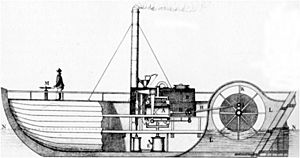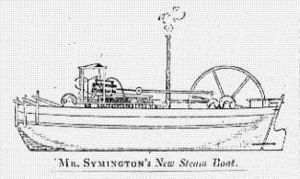Charlotte Dundas facts for kids

Charlotte Dundas cut-away drawing by Robert Bowie
|
|
Quick facts for kids History |
|
|---|---|
| Name | Charlotte Dundas |
| Namesake | Lady Charlotte Dundas (daughter of Lord Dundas) |
| Owner | Lord Dundas |
| Builder | John Allan |
| Maiden voyage | 4 January 1803 |
| Fate | Broken up, 1861 |
| Notes | Designed by William Symington (1764–1831) Model of Charlotte Dundas kept in Victoria Museum, Melbourne, Australia |
| General characteristics | |
| Type | Paddle steamer |
| Length | 56 ft (17 m) |
| Beam | 18 ft (5.5 m) |
| Depth of hold | 8 ft (2.4 m) |
| Propulsion |
|
| Speed | 2 mph (3.2 km/h) |
The Charlotte Dundas was a very important ship in history. Many people consider it the world's second successful steamboat. It was also the first steamboat designed to tow other boats. This ship showed everyone that steam power could really work for boats.
Contents
Early Steam Boat Ideas
A man named William Symington had been working on steam-powered paddle boats. But his supporter, Patrick Miller of Dalswinton, stopped funding the project. Symington kept building steam engines for pumps and mills. In 1793, he created a new way to transfer power from the engine to a crank.
Lord Dundas, who was in charge of the Forth and Clyde Canal Company, heard about Miller's project. He also knew about Captain John Schank's failed attempt at a steam tug boat for canals. On June 5, 1800, Lord Dundas suggested building a new boat. It would use Captain Schank's boat design and Mr. Symington's steam engine.
A boat was built in Grangemouth by Alexander Hart, following Symington's plans. It had a vertical engine that powered the paddlewheels. Tests on the River Carron in June 1801 went well. This first boat might have been called Charlotte Dundas. During the tests, it even towed sloops from the river Forth up the Carron. Then it went along the Forth and Clyde Canal. However, people worried that the waves from the boat would damage the canal banks. Also, the boat might not have been strong enough for the canal. So, the canal company stopped further tests.
The Famous Charlotte Dundas

In 1801, Symington got a patent for a new type of steam engine. It was a horizontal engine directly connected to a crank. Lord Dundas supported him in building a second steamboat. This boat became famous as the Charlotte Dundas. It was named after Lord Dundas's daughter.
Building the Ship
Symington designed a new hull for his powerful horizontal engine. The engine turned a large paddle wheel in the middle of the boat. This design was meant to prevent damage to the canal banks. The new boat was about 56 ft (17.1 m) long. It was 18 ft (5.5 m) wide and 8 ft (2.4 m) deep. It had a wooden hull.
After a model of the boat was shown to Lord Dundas, the real boat was built. John Allan built the boat itself. The Carron Company built the engine.
Its First Journey
The first time the Charlotte Dundas sailed was on the canal in Glasgow. This happened on January 4, 1803. Lord Dundas and some of his family and friends were on board. After a few improvements, the ship had an important test in March 1803. The Charlotte Dundas towed two large barges. Each barge weighed 70 tons. It pulled them for about 30 km (19 mi) along the Forth and Clyde Canal to Glasgow. Even though there was "a strong breeze right ahead" that stopped other canal boats, it only took nine and a quarter hours. This meant the boat traveled at an average speed of about 3 kilometres per hour (1.9 mph). This test clearly showed that steam power could successfully tow boats.
Why the Project Ended
There were plans to use these boats on the Forth and Clyde canal. But these plans were stopped. People were mostly worried that the boat's waves would damage the canal banks. Also, a project to build tug boats for the Bridgewater Canal ended. This was because the Duke of Bridgewater, who supported it, died just before the March trial.
The Charlotte Dundas was left in a quiet part of the canal at Bainsford. It stayed there until it was taken apart in 1861. Symington did not get all the money he had spent building the Charlotte Dundas. He was disappointed. However, other people continued to develop steamboats. These included Robert Fulton in the United States and Henry Bell in Scotland.
See also

